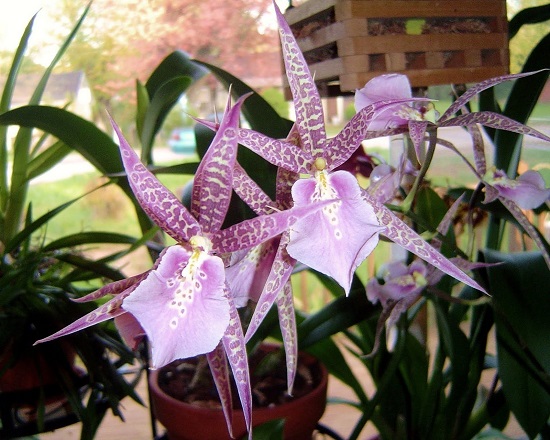
By providing the same temperature, humidity, light, water and nutrients that are found in their natural environment, Brassia orchid care can be properly administered. The genus of Brassia can be found naturally in Central and South America and the West Indies. There is at least one that can be found in South Florida. They grow naturally mainly in wet forests at elevations that range from sea level up to 3,000 feet above sea level. Brassia orchids are epiphytic plants which anchor themselves to the bark of trees. The temperature where they are found naturally averages 55 to 60 degrees Fahrenheit during the night and 65 to 70 degrees during the daytime. Understanding these factors helps determine plant care.
Temperature
With the average temperatures listed above it can be determined that an optimal temperature during the growing season will be between 75 and 80 degrees Fahrenheit. From the same measurements, it is determined that the lowest optimal temperature would be about 65 degrees Fahrenheit.
Humidity
Because Brassia are found in wet forests and at low elevations, you can safely say that they prefer humid conditions. Lower elevations are known to be more humid than higher elevations. To survive during drier times, epiphytic plants absorb moisture from the air making humidity a necessity. 70% humidity is necessary for the optimal health of an epiphytic plant with 50% humidity being a minimum requirement. A humidity tray may be needed if you are attempting to grow Brassia in your home.
Light
The amount of light needed can be determined from where these orchid plants reside. When the sun is low enough to get under the tree canopy as in early morning or early evening, the Brassia orchids get direct sunlight because they grow naturally on tree branches and fallen trees on the forest floor. The middle of the day they receive partially shaded light. Closer to the equator, Central and South America receives the sun longer and brighter each day than you would farther from the equator as most of North America is. Because of this the duration and intensity of the light orchid plants get in this region will be greater than that of plants found in North America. If you will be growing Brassia outside of these regions you may need supplemental light during the spring and fall to provide optimal conditions.
A good indicator of whether your orchid is getting the right amount of light can be determined by the color of the leaves. Mid green color leaves are what you are ideal. If the orchid is not getting enough light the leaves will begin to turn dark green and light will need to be increased. If they are getting too much light they will turn yellow and the amount of light will need to be decreased. If you change the amount of light your orchid receives and you see no change in leaf color then change your fertilizing schedule to adjust the color.
Water
In the Brassia orchids natural environment there is heavy dew in the morning and a torrential rain at least once a week. So mist the leaves every morning during the warm growing season. Water the orchid thoroughly until all the media is soaked to mimic a torrential rain. You can soak the entire pot in water 15 minutes to allow for the potting media to absorb the water if you are growing it in a pot. Brassia are highly susceptible to root rot so it is very important that water is not left standing in the pot.
Nutrients
In nature when it rains as water runs down the tree or branches and flows between the cracks in the bark the Brassia orchid roots attached to the bark absorb both water and nutrients. The nutrients that are absorbed come from decaying material from the tree and feces from birds and animals. Trying to mimic this process would be very difficult but the proper use of can overcome this. For fertilizing Brassia a balanced fertilizer works best. Use a solution one quarter of the strength that is called for on the instructions of the fertilizer package. After watering your plant apply the fertilizer three times out of four. On the fourth time flush with water only to remove minerals that build up on the potting medium from the fertilizer. Water every other week and do not fertilize during the cool months when the orchid is in its rest state. The watering frequency during this time should be just often enough so the plant does not dry out.
Re-Potting
Re-potting will be necessary occasionally. Re-potting will not only be needed if the potting medium begins to decompose but also in the case that the plant needs to be divided because of new pseudo bulbs added each year. If the potting medium begins to smell bad it is decomposing and will need to be re-potted right away. You will also need to re-pot the plant if any mold or fungus appears on the potting medium. Brassia orchids require that the potting medium be well aerated. Potting media must drain well because epiphytic orchids are sensitive to over watering. Using a mix of sphagnum moss, charcoal, perlite and coarse grade bark is preferred by many growers.
Brassia orchid care requires a little more time, effort and resources than some of the other more popular orchids when grown indoors or in the northern parts of the US. More expense might be needed if you have to purchase a humidity tray, orchid growing lights or a greenhouse to properly care for them.
Related Articles & Free Email Newsletter
4 Popular Orchid Propagation Methods
Curious About CBD? Here’s What it Can and Cannot Do for You




Comment here